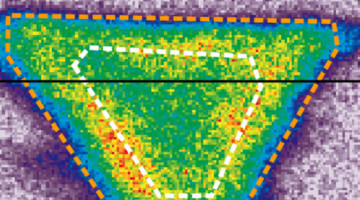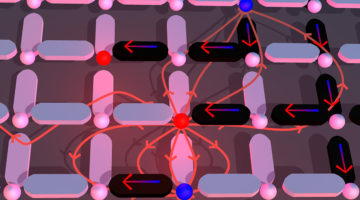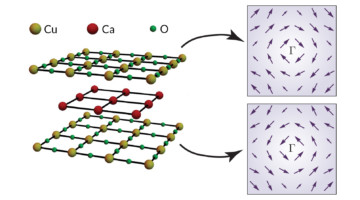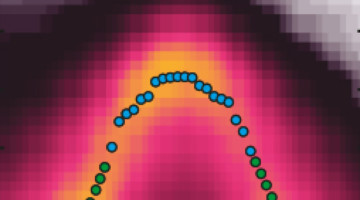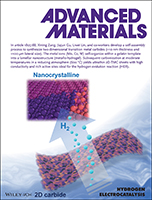In the first comprehensive study at the ALS involving nanoARPES, researchers probed the electronic effects of defects in monolayer tungsten disulfide at the nanoscale. The extremely small scale of the measurements makes nanoARPES a great discovery tool that will be particularly useful for understanding new materials as they are invented. Read more »
Scientists Take a Deep Dive Into the Imperfect World of 2D Materials
Researchers combined a toolbox of techniques to home in on natural, nanoscale defects formed in the manufacture of monolayer WS2, measuring their electronic effects in detail not possible before. The latest result marks the first comprehensive study at the ALS involving nanoARPES, which researchers enlisted to probe the 2D samples with x-rays. Read more »
How to Catch a Magnetic Monopole in the Act
A research team has created a nanoscale “playground” on a chip that simulates the formation of exotic magnetic particles called “monopoles.” The study could unlock the secrets to ever-smaller, more powerful memory devices, microelectronics, and next-generation hard drives that employ the power of magnetic spin to store data. Read more »
Spin-Momentum Locking in Cuprate High-Temperature Superconductors
A form of spin-momentum locking, similar to the strong linkage between electron spin and momentum in topological insulators, has been found in a cuprate superconductor. The results open a new chapter in the mystery of high-temperature superconductors, suggesting that new, unexplored interactions and mechanisms might be at play. Read more »![]()
![]()
Electric-Field Switching of Topological Phase
Researchers have successfully switched a topological insulator on and off by applying an electrical field. The work represents a major advancement toward the creation of a functioning topological transistor that would allow devices to operate more efficiently at lower power than conventional electronics. Read more »![]()
![]()
Pressure-driven band gap engineering in ion-conducting semiconductor silver orthophosphate
This work explores a novel method to tune the electronic band structures of active semiconductor photocatalysts to gain insight into structure–property relationships. Taking silver orthophosphate (Ag3PO4) as an example, a static pressure technique was applied to modulate the band gap and indirect–direct band character via altering its crystal structure and lattice parameters. Read more »
Memristor Collaboration between ALS and Hewlett Packard Labs Propels Theory to Application
The development of an idea into a commercial product can take decades, a timeframe that allows contributions from multiple generations of scientists and requires investment in basic research. Collaborative research between the ALS and Hewlett Packard Labs has advanced the memristor, a device that can store information using little to no power. Read more »
Self‐Assembly of Large‐Area 2D Polycrystalline Transition Metal Carbides for Hydrogen Electrocatalysis
Xining Zang et al. develop a self‐assembly process to synthesize 2D transition metal carbides (TMCs). The metal ions (Mo, Co, W) self‐organize within a gelatin template into a lamellar nanostructure. Subsequent carbonization at moderate temperatures in a reducing atmosphere yields ultrathin 2D‐TMC sheets with high conductivity and rich active sites ideal for the hydrogen evolution reaction. Read more »
Magnetic Skyrmions: Current‐Induced Skyrmion Generation through Morphological Thermal Transitions in Chiral Ferromagnetic Heterostructures
Magnetic skyrmions are particle‐like chiral twists of the magnetization that promise advances in spin‐based data storage and logic device applications. In this article, researchers examine current‐induced generation of skyrmions in heavy‐metal/ferromagnet multilayers and show that Joule heat pulses can drive topological transitions in magnetic textures and enable skyrmion creation on nanosecond timescales. Read more »
Tunable Ferromagnetism in a 2D Material at Room Temperature
Researchers combined soft x-ray spectroscopy and microscopy to demonstrate the tunable ferromagnetic characteristics of a two-dimensional layered material at room temperature. The results open up exciting opportunities for the use of such materials in low-power spintronics, high-density magnetic storage, and flexible electronics. Read more »
- « Previous Page
- 1
- …
- 14
- 15
- 16
- 17
- 18
- …
- 26
- Next Page »
